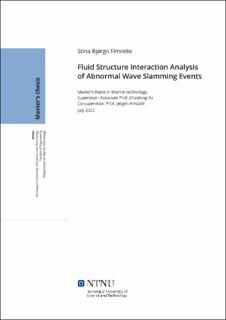| dc.description.abstract | I ekstreme sjøtilstandar kan bølgeslag påføre marine konstruksjonar store deformasjonar. Bølgeslag påfører konstruksjonen høge trykk med store variasjonar i tid og stad. Samankoplinga mellom hydrodynamiske laster og strukturell respons påverkar begge element, noko som fører til eit komplekst ikkje-lineært problem. Det finst analytiske modellar som beskriv både den elastiske og elasto-plastiske responsen til konstruksjonar, men desse er idealiserte. For ei fullstendig forståing av fenomenet er det derfor viktig med både eksperimentelle og numeriske studiar av bølgeslag.
Gjennom SINTEF Ocean prosjektet SLADE KNP ble det gjennomført eksperimentelle fall-testar av ei ustiva plate i stilleståande vatn som ei idealisering av bølgeslag. Plata vart sleppt med vinkel 0◦ og 4◦ mellom plate og vassoverflate. Disse eksperimenta har blitt modellert numerisk i LS-DYNA ved hjelp av ein ALE-metode. Deformasjonane til plata målt frå eksperimenta og dei numeriske simuleringane samsvarte godt. Dette verifiserte den numeriske modelleringsteknikken.
Vidare vart bølgeslag mot ei sylindrisk flytande vindturbinfundamentsøyle analysert ved hjelp av numerisk simulerte fall-testar. Ein ikkje-deformerbar modell vart simulert som samanlikning med teori, noko som gav godt samsvar for trykkimpuls påført konstruksjonen under prosessen. Simuleringar av ei deformerbar søyle gav store permanente deformasjonar og spenningskonsentrasjonar med størrelse nær flytspenning. Det er forventa at dette gir redusert kapasitet i den skada tilstanden. Grensetilfelle for den fysiske representasjonen av bølgeslaget er presentert, noko som gir avgrensingar for responsen til konstruksjonen.
Designtrykk frå DNV OTG-14 blei også påført søyla. Dette gav elastiske vibrasjonar og ingen permanente deformasjonar. Samalikna med relevante fall-simuleringar undervurderer denne metoden deformasjonane til konstruksjonen, noko som gir ikkje-konservative resultat. Dette illustrerer behovet for vidare studiar av designmetodar som tek høgde for bølgeslag. | |
| dc.description.abstract | During extreme sea conditions, slamming impact from large waves may cause significant damage to marine structures. Wave slamming induces high pressures with large spatial and temporal variations on the structure. During the impact, coupling between the hydrodynamic loads and structural response is important, and leads to a complex non-linear problem. While analytical models for describing both elastic and elasto-plastic response of the structures exist, these are idealised. Experimental and numerical assessments of wave impact are therefore necessary for sufficient understanding of the phenomenon.
Experimental drop tests of an unstiffened plate into still water were performed in the SINTEF Ocean project SLADE KNP to simulate wave impact. Plate impact with deadrise angles 0◦ and 4◦ were studied. These experiments have been numerically modeled using an ALE method in LS-DYNA and simulated. The numerical simulations found good accuracy between numerically and experimentally measured deformations of the impacting plate, verifying the modeling technique.
Further, slamming impact of a cylindrical floating wind turbine foundation column has been studied trough numerically simulated drop tests. A rigid model was simulated for comparison against theory, finding good accordance in pressure impulse acting on the structure. During deformable impact simulations of the column, significant permanent damage was caused to the structure. Residual stresses in the range of yield stress were also found, which are expected to decrease capacity in the damaged condition. Limiting cases for the physical representation are presented, giving limits for structural response.
Design pressures according to DNV OTG 14 were also applied to the cylindrical column, causing elastic vibrations and no permanent deformations. Compared to relevant drop simulations, the pressure impulse method is found to severely underestimate the structural response, providing unconservative results. This illustrates a need for further studies into design principles against slamming impact. | |
